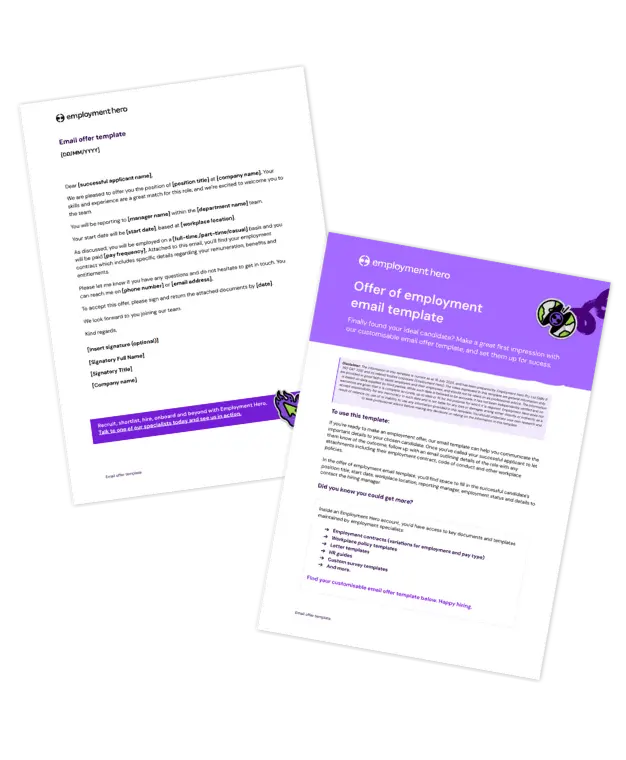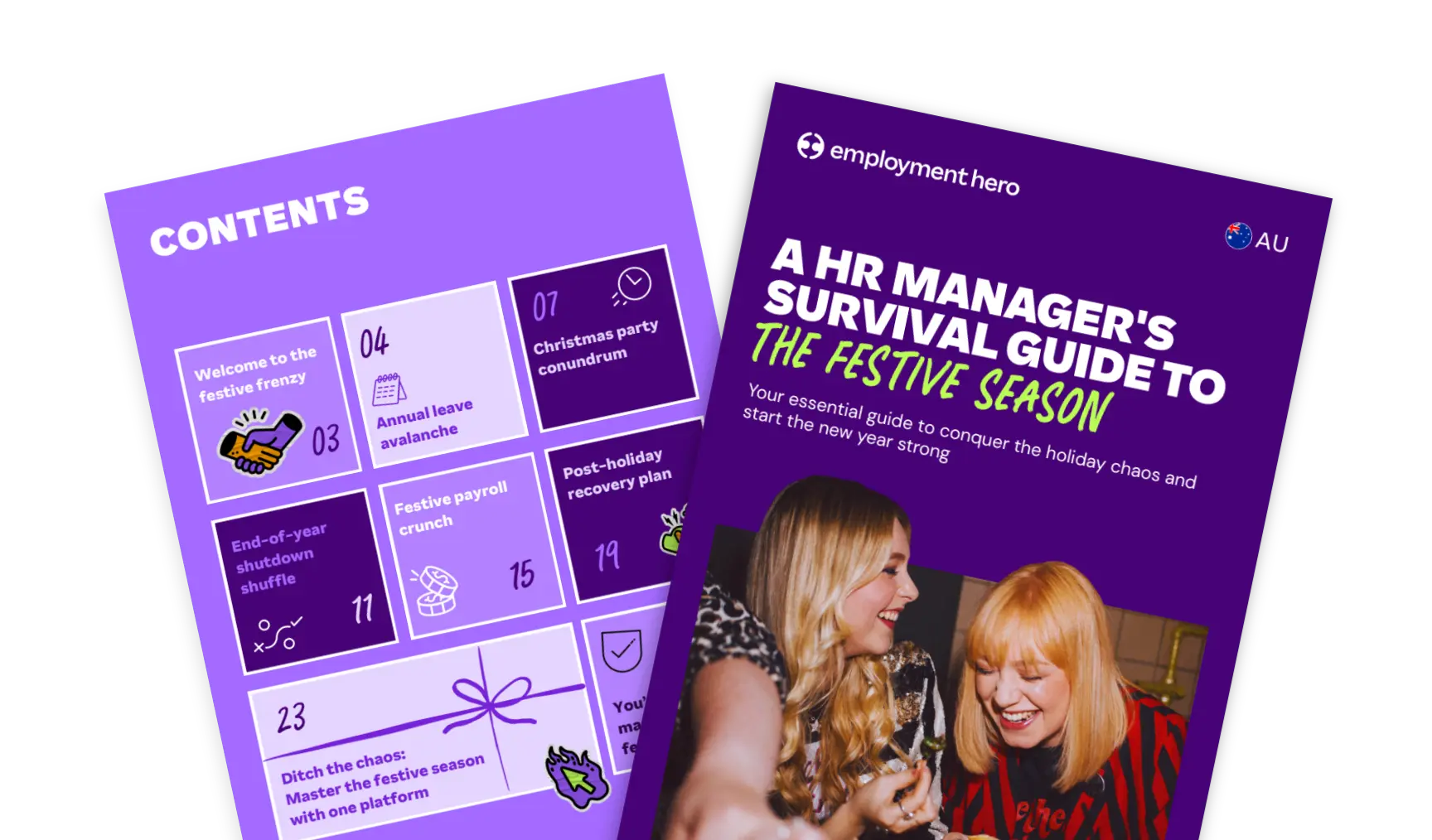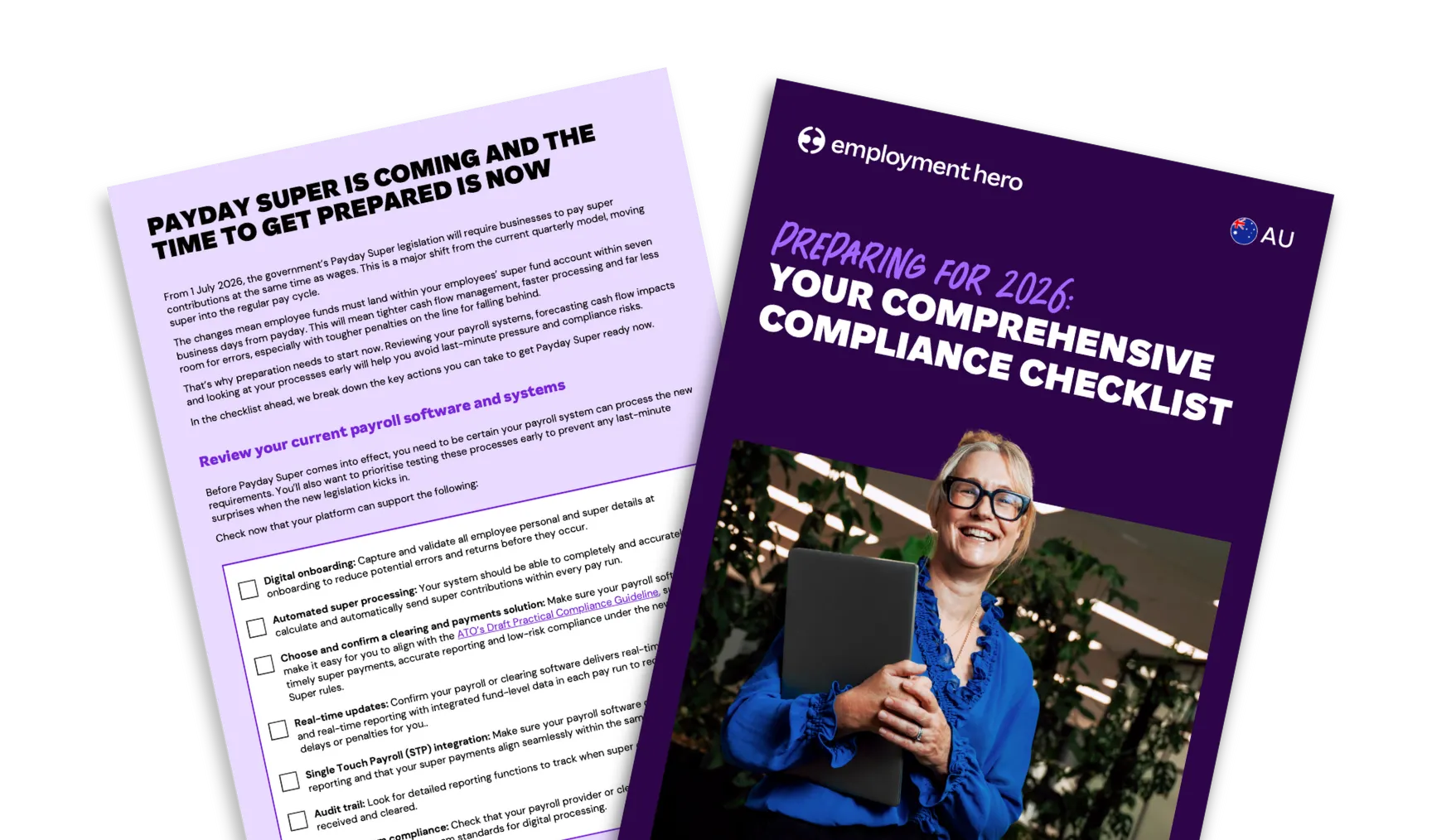Employment offer letter email template [free download]
Published
Employment offer letter email template [free download]

It’s one of the best parts of any hiring or HR manager’s job. After a long recruitment process, you’re finally ready to make someone’s day and officially offer them a position with your business. Congrats!
If you’re approaching the end of the interview process and are ready to take this exciting step, our email template can help you feel prepared when it comes time for communicating the important details.
What’s in this employment offer letter template?
Sometimes it can be hard to clearly put all of the important details in one email. That’s where this letter of offer template helps.
Once you’ve called your successful applicant to let them know of the outcome, you can use our fully customisable template to share the details of their offer.
This job offer letter and email template includes;
- A friendly introduction and congratulations
- A brief introduction to the person’s new team and manager
- A place to include the person’s start date and workplace location
- The basics of their employment
- Information on how to contact the business if any questions arise
Download the free template now.
What is a job offer letter?
A job offer letter or email is official correspondence that you may wish to send to a candidate who has successfully secured a role with your business.
It’s normally preceded by a phone call to the candidate to informally let them know that they’ve been successful in their application.
The job offer letter, usually sent straight after the phone call, is the more formal part of the equation. While you might have shared some initial details in the phone call, this letter will have details like the successful candidate’s position title, start date, workplace location, reporting manager, employment status, as well as details for how to contact the hiring manager.
Usually attached to a job offer letter is a person’s employment contract. The candidate might verbally accept the offer over the phone, but the formal acceptance generally comes in the form of signing and returning the employment contract.
Sometimes an employee handbook is also included as an attachment, but some businesses choose to share the employee handbook only after the new employee signs their contract.

What should be included in an employment offer letter?
Your offer letter sets the stage for your employee’s journey, so it’s worth getting right. Make sure it clearly outlines the role, expectations, and the terms of employment. It should also be sent to the successful candidate alongside an employment contract.
Include a job position
Outline what the role is and what success looks like. A clearly defined job position helps your new hire understand their responsibilities and what’s expected from them.
Include a legally binding agreement (the employment contract)
An offer letter should outline key employment terms, and be distributed alongside a full employment contract. This protects both parties.
Include a job title
Don’t overlook the basics. Be sure to include the job title in the letter to ensure clarity around the role.
Include an offer letter expiration date
Sometimes employment offers aren’t accepted. Adding a final date for the documents to be signed and returned can help with planning. You should also include contact details if the candidate has any concerns they’d like to raise before signing.

What other job offers can employers use?
There’s more than one way to make a job offer, and the format you choose can impact your hiring process, employment obligations, and candidate experience. We’ve outlined a couple of common ways outside of the standard job offer letter below.
Verbal job offer
A quick call can move things along, and remember verbal offers are still binding. However, to make sure everyone is on the same page, always follow up with a written letter and contract to avoid any misunderstandings.
Conditional job offer
Need to run background checks or confirm qualifications? A conditional offer lets you move forward, while still protecting your business until all requirements of the position are met.
Casual vs permanent offers of employment
Not every role needs to be permanent. Casual roles offer you flexibility, while permanent roles provide stability. No matter which option you choose, it’s important to be aware that they all come with different entitlements that you need to be across.

Can an email be sent as an official job offer letter?
Yes.
These days, very few job offers are communicated through a letter that’s physically posted to the successful candidate. Busy employers don’t have time to print out letters, wait for them to be delivered, and stand by for them to be acknowledged. This can become an even more laborious process when you’re printing out employment contracts to be sent with the job offer letter.
Email is by far the most efficient and effective way to communicate a job offer. It’s fast, easy and paperless. Your candidate won’t be left waiting by the letterbox for their employment details, they can be informed instantly (making it easier for them to give their official confirmation sooner). In such a competitive recruitment market, speed is everything, and this extends to your job offers.
Another big advantage of using a job offer email is you can attach digital contracts. But if you’re looking to do it all from one place, our digital contracts can be sent straight to the successful candidate where they can digitally accept them within minutes.
Learn more about our onboarding software.
What happens after you send a job offer letter?
Hopefully after you send a job offer letter or email, you’ll get a swift response from the candidate with an excited “Yes!” and a signed employment contract.
Once you have this signed contract, your candidate has formally accepted your offer and you can get the ball rolling with their employment. Onboarding should start from the time that your new team member signs on the dotted line, so don’t overlook those important few weeks between job acceptance and first day.
Does a reference check happen before or after a job offer?
Reference checks generally occur prior to the job offer being issued, or just after the job offer is issued. If the reference checks have not yet been completed by the time you make the offer, it’s worth making a note that the offer is “pending reference checks”.
Reference checks are an important part of the recruitment process. Reference checks allow hiring or HR managers to cross-reference if the candidate has the technical skills, employment history and qualifications that they say they have.
It can also be an opportunity for the hiring manager to ask about the person’s working and professional manner.
Make sure you then complete these reference checks quickly, so you don’t delay the onboarding process.
Learn more about how to conduct an effective reference check.

Why do candidates decline job offers?
There is also a chance that your candidate will decline your job offer, or request more time to consider it. Let’s look at the most common reasons why candidates decline job offers, and consider any methods to boost your business’ appeal to secure candidates.
They’ve accepted another job offer
It’s likely that job seekers will be pursuing more than one role at a time. Before you even get a chance to make your offer, they may have been made another one by a different company.
This can be difficult to address, but if the person is willing to share the details of the other offer, you may be able to counter this with a higher annual base salary or any other extra benefits.
If this doesn’t work out in your favour, graciously accept defeat. You never know, they may not enjoy their first months with a new employer and be interested in a role at your business down the track.
Their current employer has countered your offer
It’s not uncommon for an employee to, while resigning from their current role, be made a counter offer to stay.
Again, you may be able to win them over with additional perks or remuneration, but it could be difficult to convince them if they’re not sold on taking the plunge on a new opportunity.
They don’t find your salary competitive
A very common reason why candidates walk away from job offers is that they’re just not satisfied with the salary on offer.
You can try to work around this by asking what the candidate’s salary expectations are in the first interview. You should also do your research to make sure that your offer aligns with the market standard, and be prepared to negotiate if you can.
There aren’t enough progression opportunities
During the hiring process, it’s likely that your candidate asked some questions about the position’s job duties, the team and progression opportunities within the business. If it turns out that the position doesn’t have the progression possibilities they were looking for, they may decline your job offer.
At this point, you may decide to graciously acknowledge their decline and continue with other job offers. You want to be transparent about the opportunities available, and if that doesn’t line up with their career plan, someone else may be more suitable.
They didn’t enjoy the candidate experience
Your candidate is unlikely to share this reason for declining an offer with you, but it’s possible that they didn’t enjoy the candidate experience during the hiring process.
If you find that you’re losing many qualified candidates during the recruitment process, it may be time to review your strategy. Maybe your process is taking too long or is demanding too much of applicants. Maybe one of your hiring managers needs further training when it comes to interviewing, or maybe the candidate pipeline is disorganised, causing miscommunications.

Is a job offer letter legally binding in Australia?
In Australia a job offer letter can be legally binding once it’s accepted by the candidate. That’s why it’s crucial to make sure the terms are clear and accurately reflect the employment arrangement. A well-drafted letter, along with an employment contract protects both your business and your new hire from day one.
Need some help managing the legal side of employment? Employment Hero’s HR Advisory service gives you direct access to qualified HR experts when you need support most.
Whether you’re navigating complex employee issues, refining your workplace policies, or seeking guidance on employment law, our advisors are here to help. Get in touch with our team today to learn more.
Moving through to onboarding
Assuming that you’ve successfully secured your new employee with your job offer letter, you can move onto onboarding.
Onboarding starts well before an employee’s start date, so it’s time to get moving. You can find a step-by-step guide to an incredible onboarding experience in our employee onboarding guide, but for now let’s take a quick look at the steps you can take immediately after an employee accepts the offer.
Before your new employee’s first day
- Prepare your new employee’s work area and office space and equip it with supplies
- Order appropriate access keys/security cards and make sure they work
- Order business cards, if applicable
- Arrange for parking, if required
- Order technology equipment (computer, iPad, phone) and software
- Set up their system in advance and assign them to a printer
- Arrange for access to common drives
- Add their name to relevant email lists
- Collect some company merchandise and put together a welcome pack
- Give them details about any remote working allowances (remote and hybrid employees only)
- Send out any equipment and technology via a courier (remote and hybrid employees only)
- Share the news about the new starter with everyone in the business so everyone’s ready for their introduction. It’s a good idea to share something personal about your new hire such as their love of coffee or their favourite footy team. In this way, other employees have something they can use to break the ice with them when they meet
- Assign a buddy or mentor the new hire can rely on to show them the ropes and answer their questions
- Give the person a quick call to make sure they have everything they need, or if they have any questions about day one

How can Employment Hero help?
There’s too much at stake to leave HR compliance to chance. Our end-to-end Employment Operating System takes the stress out of creating and managing job offers.
With customisable contract templates, a powerful applicant tracking system (ATS), digital acknowledgement tool, and seamless onboarding, you can move fast while knowing that everything is documented in-platform.
And if you’re looking to create HR processes that are unique to your business, our HR advisory team is on hand to help you pull together all of the essential documents you need.
Frequently Asked Questions
Yes, but in Australia, specific conditions apply. If the offer hasn’t been accepted yet, you can usually rescind it. However, once it has been accepted by the successful candidate, it may be legally binding.
If you’re in this situation, we suggest seeking advice before taking action (which our HR advisory team can help with).
The total contribution of a pension scheme using a qualifying earnings basis, is 8% of qualifying earnings, of which the employer must contribute at least 3% and the remaining 5% is to be paid by the employee.
Yes. It’s very common for candidates to come back with questions, changes or requests relating to their employment contract. These questions typically are related to salary, benefits, or flexibility.
Businesses should approach salary discussions with transparency and preparation. Have a clear idea of your budget and be ready to explain how pay aligns with the value of the role.
Disclaimer: The information in this article is current as at 26 June 2025, and has been prepared by Employment Hero Pty Ltd (ABN 11 160 047 709) and its related bodies corporate (Employment Hero). The views expressed in this article are general information only, are provided in good faith to assist employers and their employees, and should not be relied on as professional advice. The Information is based on data supplied by third parties. While such data is believed to be accurate, it has not been independently verified and no warranties are given that it is complete, accurate, up to date or fit for the purpose for which it is required. Employment Hero does not accept responsibility for any inaccuracy in such data and is not liable for any loss or damages arising either directly or indirectly as a result of reliance on, use of or inability to use any information provided in this article. You should undertake your own research and to seek professional advice before making any decisions or relying on the information in this article.
Register for the Downloadable
Related Resources
-
 Read more: HR Managers: Don’t just survive the festive season, master it
Read more: HR Managers: Don’t just survive the festive season, master itHR Managers: Don’t just survive the festive season, master it
Make year-end easier: manage leave, payroll, parties and shutdowns with confidence. Get practical tips for Australian SMEs. Download the free…
-
 Read more: Preparing for 2026: Your Compliance Checklist
Read more: Preparing for 2026: Your Compliance ChecklistPreparing for 2026: Your Compliance Checklist
Get your business ready for the 1 July 2026 changes. See practical steps for Payday Super, cash flow planning and…
-
 Read more: Monthly business budget template for employers
Read more: Monthly business budget template for employersMonthly business budget template for employers
Plan your monthly income and expenses with our free monthly business budget template. Download today to track cash flow and…























